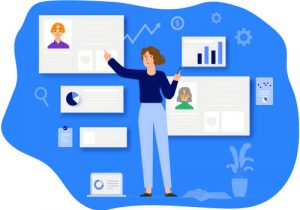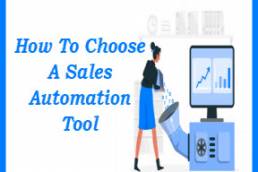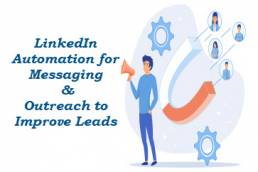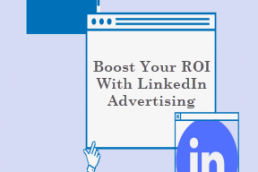LinkedIn has introduced a LinkedIn Relationship Explorer feature for B2B marketers and sellers. This LinkedIn tool will help you track the relationships between your customers and prospects and make better decisions based on data.
Inside LinkedIn’s new Relationship Explorer
LinkedIn has long been a powerful platform for business networking and relationship building. Now, the company is introducing a new feature called “LinkedIn Relationship Explorer” that takes things to the next level.
With Relationship Explorer, LinkedIn users can see how they are connected to other users on the platform. They can also see the strength of those connections and get recommendations for ways to further develop those relationships.
This is a valuable tool for salespeople and business development professionals who are looking to expand their networks and build stronger relationships with potential customers and partners. It can also be used by recruiters to identify potential candidates for open positions.
The Relationship Explorer feature is available for LinkedIn Sales Navigator Members.
- Defining ideal audiences
As a business-to-business (B2B) marketer or seller, you know that developing relationships is key to success. But keeping track of all your relationships, and understanding the nuances of each one, can be a full-time job in itself.
LinkedIn’s new Relationship Intelligence feature aims to make your job a little easier by giving you a 360-degree view of your relationships with potential and current customers.
The feature, which is available for LinkedIn Sales Navigator users, shows you the interactions you’ve had with a person, as well as the interactions your connections have with that person. It also shows you how you’re connected to that person, and gives you a list of potential next steps you can take to nurture the relationship.
To use Relationship Intelligence, log in to LinkedIn Sales Navigator and click on the “Relationships” tab. Then, click on the name of the person you want to learn more about.
If you don’t know how to use LinkedIn Sales Navigator Click Here
On the right-hand side of the screen, you’ll see a list of your recent interactions with that person, as well as a list of your mutual connections. Click on any of the mutual connections to see the interactions they’ve had with the person you’re researching.
You can also use the “Next Steps” feature to get ideas on how to move the relationship forward. LinkedIn will suggest actions such as sending a message, scheduling a meeting, or connecting on a call, based on your past interactions with the person and the interactions of your mutual connections.
- Surfacing key people to know
As a business professional, it’s important to build and maintain relationships with key people in your industry. LinkedIn’s new Relationship Intelligence feature can help you keep track of your relationships and identify key people to know.
The Relationship explorer is a great way to stay on top of your relationships and identify key people to know. If you’re not already using LinkedIn, now is the time to start!
- New insights into the Intent
As the world of work continues to evolve, so does the way we connect. LinkedIn’s new Relationship Intelligence feature is designed to help B2B marketers better understand their relationships with potential customers. Here are three key insights that this new feature can provide:
How well do you know your prospects: LinkedIn’s Relationship explorer feature can help you better understand how well you know your prospects. It can show you how often you’ve interacted with them, how strong your connection is, and whether you have any mutual connections. This information can be extremely valuable when you’re trying to decide how best to approach a potential customer.
What your prospects are interested in: The Relationship Intelligence feature can also show you what your prospects are interested in. This information can be used to tailor your sales pitch and make sure you’re talking about the things that are most relevant to them.
How likely your prospects are to convert: Finally, the Relationship Intelligence feature can help you understand how likely your prospects are to convert. This information is based on their LinkedIn activity, as well as their interactions with you and your company. This can be extremely valuable when you’re trying to prioritize your sales leads.
Overall, LinkedIn’s new Relationship Intelligence feature is a valuable tool for B2B marketers and sellers. It can help you better understand your prospects, tailor your sales pitch, and prioritize your leads. If you’re not already using this feature, be sure to check it out!
- Optimized search
LinkedIn’s Relationship Intelligence explorer is based on the company’s “Social Graph” data, which contains information on the relationships between LinkedIn members. The new feature provides users with information on their “1st degree” connections, or the people they are connected to on LinkedIn. The feature also provides users with information on their “2nd degree” connections, or the people who are connected to their 1st-degree connections.
The new feature includes a “People You May Know” section, which provides users with information on people with who they may be interested in connecting with. The section includes information on the person’s job title, company, and location. The section also includes a “Reason to Connect” section, which provides users with information on why the person may be a good connection for the user.
- Customized CRM account list views
LinkedIn is likewise enhancing its present CRM Auto-Save characteristic in 2 ways.
New user setting options will allow the sellers to set precise parameters for which account from their CRM will populate their “My CRM Accounts list” being as narrow or as broad as they pick. Plus, users will now have the option to remove accounts on its “My CRM Account List” that they don’t desire to look in the list. Edits of this sort won’t remove the user from the actual CRM but will allow sellers to ease up their list view.
This update of LinkedIn to our existing CRM Auto-Save features dramatically improves the capacity for every rep to manipulate and customize their ebook of enterprise…”
In addition, Relationship Intelligence also provides users with insights and recommendations on how to best engage with their potential customers. For example, if a sales rep is trying to connect with a potential customer who they haven’t spoken to in a while, Relationship Intelligence may recommend sending a personalized message or connecting on a social platform like Twitter.
Relationship Intelligence is available now to all LinkedIn Sales Navigator users.
What is a LinkedIn buyer persona?
A buyer persona is a semi-fictional representation of your ideal customer based on market research and real data about your existing customers. When creating a LinkedIn buyer persona, you’ll want to consider things like:
Their demographics (location, age, gender, etc.)
- Their interests
- Their needs
- Their pain points
- Their goals
By creating a LinkedIn buyer persona, you can better understand who you should be targeting with your LinkedIn marketing efforts. This will help you create content, ads, and offers that are more likely to resonate with your target audience.
Here are some tips for creating a LinkedIn buyer persona:
- Start with basic demographics
- Look at their LinkedIn profile
- Consider their motivations
- Think about their buying journey
- Make sure your persona is realistic
How can you create a LinkedIn buyer persona?

A LinkedIn buyer persona is a semi-fictional representation of your ideal customer, based on real data and research. You can use your LinkedIn buyer persona to guide your marketing and sales strategies and ensure that your content and messages are relevant to your target audience.
To create a LinkedIn buyer persona, you will need to gather data from your current and potential customers and supplement this with market research. Once you have this information, you can start to build a profile of your ideal LinkedIn buyer.
Once you have your LinkedIn buyer persona template, you will need to fill in the following information:
- Name and Photo: Give your persona a name and find a photo that represents them.
- Demographic Information: Include the demographic information you gathered above.
- Psychographic Information: Include the psychographic information you gathered above.
- Firm Graphic Information: Include the firm graphic information you gathered above.
- Pain Points: What challenges does your persona face in their work? What are their goals?
Why is it important to have a LinkedIn buyer persona?
There are several reasons why it’s important to have a LinkedIn buyer persona.
Firstly, it will help you to identify your target market.
Secondly, it will help you to understand what they’re looking for.
Thirdly, it will help you to create more effective marketing campaigns.
By understanding your target market and what they’re looking for, you can create content and campaigns that are more likely to resonate with them.
Once you have a LinkedIn buyer persona, you can start to create more targeted and effective marketing campaigns. You can use your persona to help you to understand what kind of content to create, what kind of offers to make, and what kind of language to use. By creating a LinkedIn buyer persona, you can make sure that your marketing campaigns are more likely to be successful.
How can you use a LinkedIn buyer persona to improve your marketing strategy?
If you’re in marketing, then you know how important it is to have a well-defined target audience. Without knowing who your target audience is, it’s impossible to create an effective marketing strategy. This is where a LinkedIn buyer persona comes in.
Here are five ways you can use a LinkedIn buyer persona to improve your marketing strategy:
- Create more targeted content.
If you know who your target customer is, you can create content that is specifically tailored to them. This content will be more likely to resonate with your target customer and prompt them to take action.
- Use the right keywords.
When you know who your target customer is, you can also research the keywords they are using on LinkedIn. This will allow you to optimize your content and profile for those keywords, making it more likely that your target customer will find you.
- Connect with influencers.
LinkedIn is a great place to connect with influencers in your industry. These influencers can help you reach a wider audience and promote your content to their followers.
- Join relevant groups.
LinkedIn groups are a great way to connect with like-minded professionals. When you join relevant groups, you can share your content with a larger audience and get feedback from other group members.
- Run targeted ads.
LinkedIn offers a variety of targeted ad options that allows you to reach your target customer with laser precision. By targeting your ads to your buyer persona, you can ensure that your ads are seen by the people most likely to convert.
By using a LinkedIn buyer persona, you can improve your marketing strategy and get better results. If you don’t have a buyer persona yet, now is the time to create one.
How to Create a LinkedIn Ideal Customer Profile (ICP)
Your ideal LinkedIn customer is someone who is actively engaged on the platform, looking to connect with new people and grow their network. They are also open to new opportunities and willing to engage with businesses that they are interested in.
LinkedIn is the perfect platform for B2B companies to connect with their ideal customers. But how do you create an ideal customer profile (ICP) on LinkedIn?
Here are some tips:
- First, identify your target market. Who are the companies or decision-makers that you want to reach?
- Next, create a buyer persona for each type of customer. What are their needs and pain points? What solutions are they looking for?
- Once you have a good understanding of your target market and buyer personas, you can start creating your ICP on LinkedIn. To do this, go to the LinkedIn Ads Manager and create a new ad campaign.
- In the targeting section, select “Companies” as your target type. Then, enter the criteria for your ideal customer. This could include factors like company size, industry, location, and more.
- LinkedIn will then show you a list of companies that match your criteria. From here, you can further narrow down your list by adding additional criteria, or you can start creating your ad.
- Keep in mind that your ICP is not set in stone. As your business grows and changes, so will your ideal customer. LinkedIn makes it easy to change your targeting criteria at any time, so you can always make sure you’re reaching the right people.
The Benefits of Creating a LinkedIn Ideal Customer Profile
An ICP is a detailed description of your ideal customer, based on real data and insights. It includes information like demographics, firm graphics, interests, and even psychographics.
Creating a LinkedIn Ideal Customer Profile can be helpful for several reasons. Here are just a few of the benefits:
It Helps You Target the Right Prospects
One of the most important benefits of an ICP is that it helps you identify and target the right prospects. When you know who your ideal customer is, you can create targeted content and campaigns that are more likely to resonate with them.
It Helps You Allocate Your Resources More Effectively
Another benefit of an ICP is that it can help you allocate your resources more effectively. Once you know who your ideal customer is, you can focus your time and energy on reaching them. This is a more efficient use of your resources and can help you get better results.
It Helps You Create a Unified Message
When you know who your ideal customer is, you can create a unified message that speaks to their specific needs. This is more effective than a generic message that tries to appeal to everyone.
It Helps You Measure Your Progress
An ICP can also help you measure your progress. When you know who your ideal customer is, you can track your progress in reaching them. This can help you adjust your strategy as needed and ensure that you’re on track to meet your goals.
Creating LinkedIn Ideal Customer Profile
There are three steps to creating a LinkedIn ICP:
- Define your ideal customer.
- Identify where your ideal customers hang out on LinkedIn.
- Create content that appeals to your ideal customers.
To do this, go to the LinkedIn Ads Manager and click on “Create an ICP.”
LinkedIn will then ask you to fill out some information about your ideal customer.
This includes:
- Their job title
- Their location
- Their company size
- Their seniority level
- Their industry
- Their interests
- Their skills
- Their groups
If you’re not sure where to start, there are a few resources that can help. HubSpot has a great guide on how to create an ICP. Additionally, there are several ICP templates available online.
Once you have your ICP, you can start to create targeted marketing and sales campaigns. This will help you attract more of your ideal customers and close more deals.
Final Thoughts:
LinkedIn has launched a new Relationship Intelligence feature for B2B marketers. This new feature will help marketers better understand their buyers and build more targeted and effective campaigns. The Relationship Intelligence feature is based on LinkedIn’s extensive data on buyer behavior and interactions. This data will help marketers identify key decision-makers within their target companies, understand their buying process, and develop more targeted and effective campaigns. The Buyer Persona feature will also help marketers understand their buyers’ needs and interests, and build more personalized campaigns.



